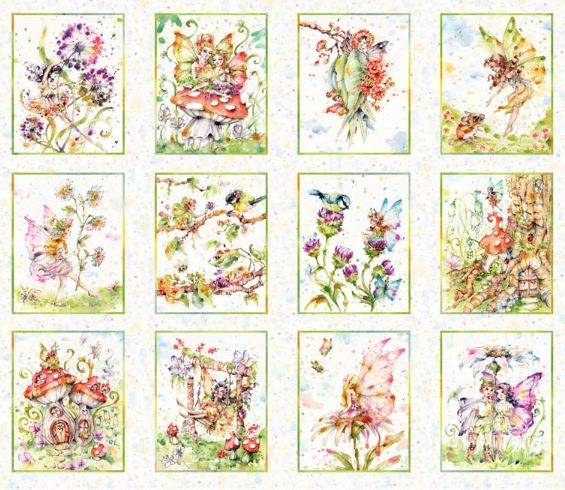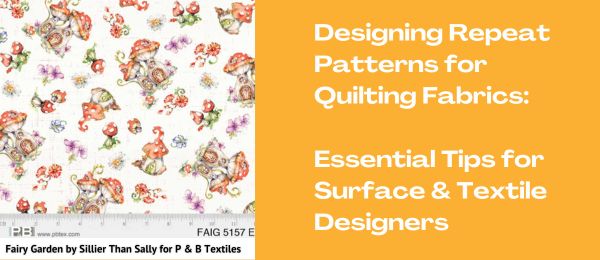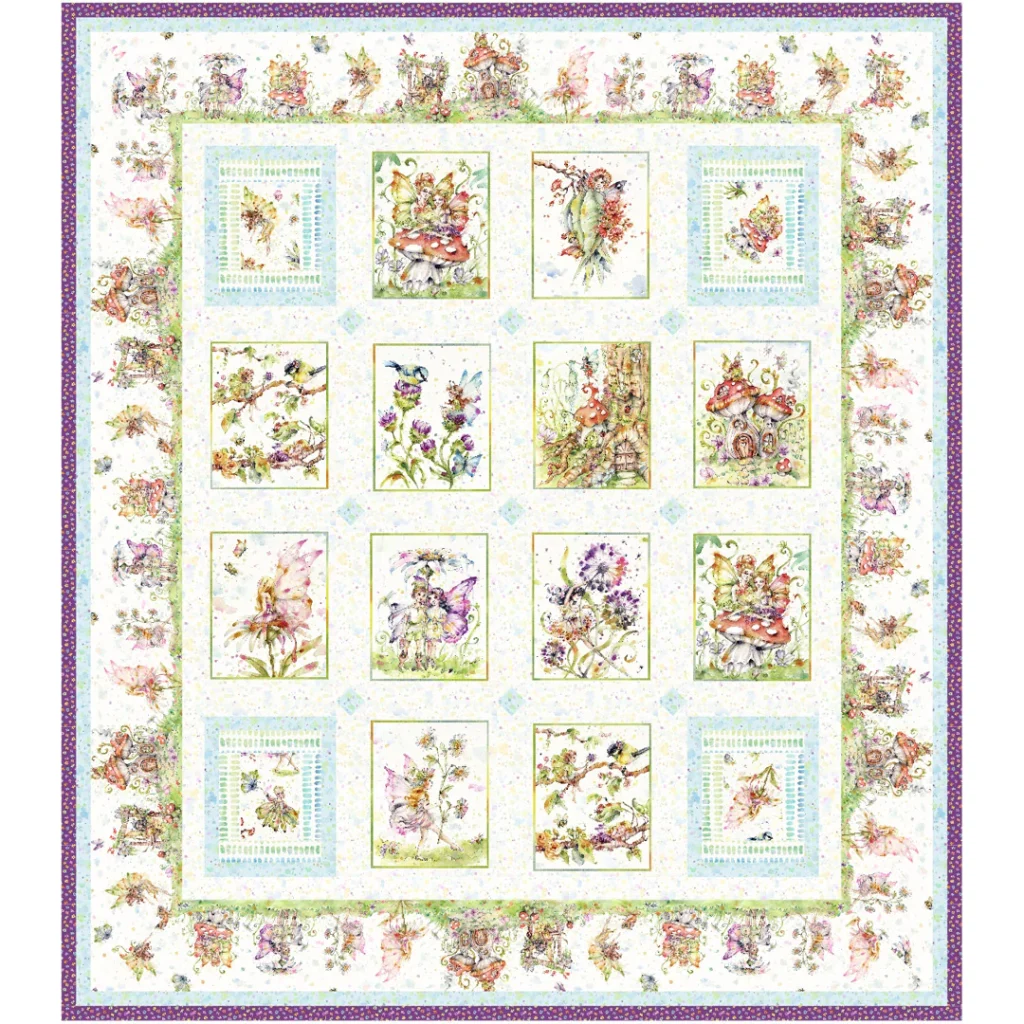Fairy Garden by Sillier Than Sally Designs for P & B Textiles
Creating repeat patterns for quilting fabrics is a specialized art within the realm of surface and textile design. It requires a deep understanding of both design principles and the unique requirements of quilting fabrics. Here are some key considerations and things that surface and textile designers need to know when creating repeat patterns for quilting fabrics:
1. Understanding the Quilter’s Perspective: Surface and textile designers must recognize that quilters have distinct preferences and needs. Quilters often seek fabric with precise patterns that align seamlessly when pieced together. To cater to this, designers should prioritize creating patterns that are easy to cut and sew, ensuring that motifs and colors align perfectly in the final quilt.
2. Tileable Design: Repeat patterns for quilting fabrics should be tileable. This means that the pattern can be repeated both horizontally and vertically without any visible seams or disruptions. Ensuring tileability is crucial because quilters often require multiple yards of fabric for larger projects.
3. The Importance of Scale: Scale plays a pivotal role in quilting fabric design. Designers must consider how their patterns will appear when scaled down for smaller quilt blocks or enlarged for larger projects. A pattern that works beautifully for a large quilt may lose its charm when reduced in size.
4. Balanced Colour Palette: Quilting fabrics should have a balanced and harmonious color palette. Designers should consider the preferences of quilters who often look for fabrics that can complement a wide range of other fabrics in their quilt projects. Versatility in color choice is a key consideration.
5. Versatile Motifs: Design motifs should be versatile and suitable for various quilt themes. While thematic patterns have their place, many quilters prefer versatile designs that can be used in a variety of projects. Geometric, floral, and abstract motifs are perennial favorites.
6. Clear and Crisp Printing: When designing for quilting fabrics, designers must keep in mind that the patterns will be closely examined by quilters. Ensuring that the printing is clear and crisp is essential. The intricacies of the design should be well-defined, and the colors should be vibrant.
7. Repeat patterns: A crucial aspect of crafting repeat patterns for quilting fabric is ensuring that the designs are versatile and can be oriented in multiple directions. These adaptable patterns not only simplify quilting projects but also lead to efficient fabric utilization, minimizing wastage.
8. Coordinate Collections: Designers may consider creating coordinate collections. This means developing a series of fabrics that can be mixed and matched within a quilt project. Quilters often look for complementary fabrics within a collection to create a cohesive quilt design.
Fairy Garden Quilt by Denise Russell Available Now.
9. Creating Art Panels as the Central Design: Art panels designed for quilting are perfect for crafting a quilt quickly and easily. By adding a few borders, your quilt can be completed in no time. As an integral part of a quilting collection, designers should seriously consider including an art panel for quilters to incorporate into their quilting projects. The art panel should serve as the centerpiece of the collection, as it provides the foundation for coordinating patterns. These coordinating designs are developed based on the main art panel, resulting in a collection with a cohesive look and feel. The main designs or art panel are often proudly showcased by quilters, typically at the center of their quilts. They skilfully utilize the coordinating patterns to create intricate designs and borders that frame the main panels beautifully.
 Fairy Garden Quilting art panel by Sillier Than Sally Designs for P & B Textiles
Fairy Garden Quilting art panel by Sillier Than Sally Designs for P & B Textiles
10. Test Printing and Sampling: Before finalizing a design, it’s advisable to conduct test printing and sampling. This ensures that the pattern repeats correctly, the colors are accurate, and any potential issues are identified and resolved. Designers should collaborate with fabric manufacturers to facilitate this process.
11. Licensing and Collaboration: Designers should be aware of licensing and collaboration opportunities within the quilting industry. Licensing their designs to fabric manufacturers or collaborating with quilting brands can provide exposure and access to a broader audience of quilters.
12. Working with a Licensing Manager: Designers should also consider partnering with an agent or licensing manager to turn their aspirations into reality. By entrusting the business side to experts, designers can devote their energies to what they excel at: creating designs and collections. Collaborating with a licensing manager grants access to opportunities and companies that might otherwise be out of reach. They can effectively oversee your portfolio, identify prospects, and accelerate your brand’s growth, sparing you the complexities of approaching companies directly. As a designer, you can only focus on a limited number of things, so concentrate on your strengths and enlist a team to handle tasks you can delegate, allowing you to channel your creativity. Furthermore, having a licensing manager represent you sets you apart from other designers. It bestows credibility and positions you differently from those without representation. Remember, licensing managers typically work with designers of high-quality and proven commercial potential.
13. Digital Tools and Software: Proficiency in digital design tools and software is essential for modern textile designers. Software like Adobe Illustrator or dedicated textile design programs can help designers create and manipulate patterns efficiently.
In conclusion, creating repeat patterns for quilting fabrics requires a unique set of skills and considerations. Surface and textile designers should focus on tileable designs, understand the quilter’s perspective, prioritize scale and color harmony, and ensure that their patterns are versatile and clear when printed. By embracing these principles, designers can contribute to the vibrant world of quilting fabrics and provide quilters with the materials they need to create stunning quilt projects.
Want to learn more?
- Find out more
- Launch Pad + Accelerator Expressions of Interest
- Selling and Licensing Your Art & Designs Around the World with ArtSHINE.
We’re here to help you to take action, just like we’ve helped thousands of other entrepreneurs, business owners, and creative professionals all around the globe.
Now is the time to let your passion SHINE.
Now is the time to Make Tomorrow Today!
To your success, Vinh Van Lam and Stuart Horrex Cofounders
ArtSHINE.com






